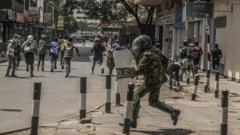A shocking report highlights that the suffocation torture method known as "tubing" still occurs among South African police forces, inadequately addressed by existing laws. This revelation points to a failure in the system meant to protect citizens, revealing a troubling legacy of violence.
South Africa's Dark Legacy: The Persistence of Police Torture

South Africa's Dark Legacy: The Persistence of Police Torture
Despite the end of apartheid, a brutal form of police torture continues to plague South Africa, raising serious human rights concerns.
It’s difficult to reconcile the enduring presence of a torture method once embraced by South Africa’s oppressive apartheid regime with a nation that celebrates leaders like Nelson Mandela, who championed human rights. However, a recent analysis by The New York Times reveals that, three decades after apartheid's demise, a form of suffocation torture referred to as “tubing” continues to be used by police, despite laws outlawing such practices.
Initially, tubing involved police officers suffocating individuals using a tightly pulled tire tube over the victim's face. In contemporary practice, this method has evolved into the use of a plastic bag drawn over the head. In partnership with Viewfinder, a South African investigative journalism organization focused on police accountability, The Times conducted a comprehensive analysis of thousands of police complaints, uncovering approximately 1,700 allegations of tubing over an 11-year span.
Experts suggest that the actual incidence of such torture may be significantly higher, considering that many victims refrain from filing complaints due to fear of repercussions. This groundbreaking analysis sheds light on a distressing reality: a government once hailed for liberating Black South Africans from apartheid is now presiding over a police force committing acts of torture against the same community.

















